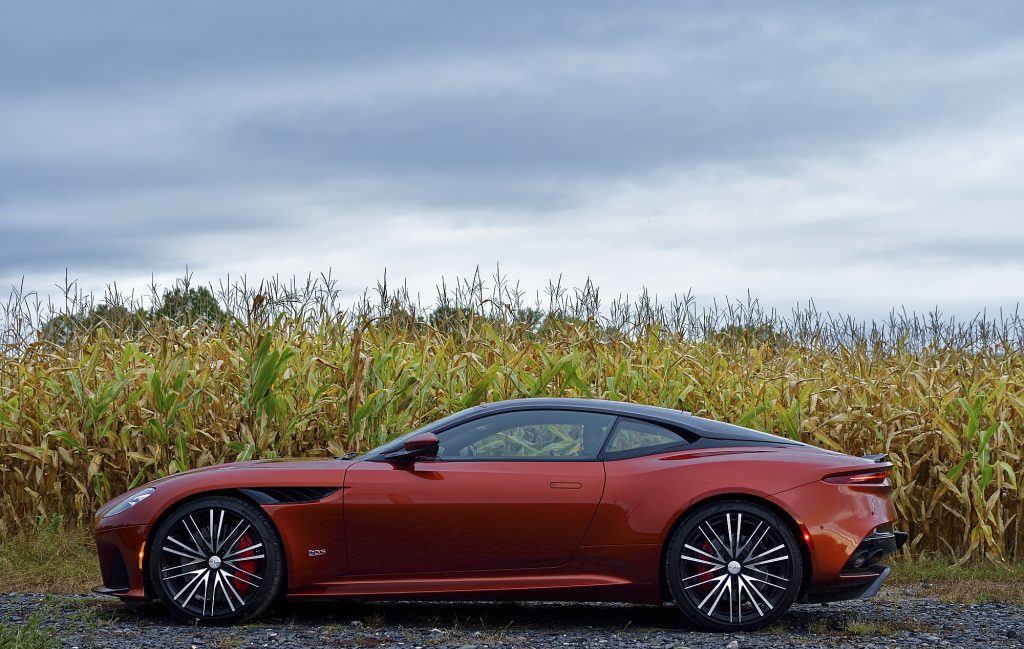Lining up Lamborghini’s Huracán STO with Aston Martin’s DBS
Two stunning supercars and where they diverge

One may be tempted to compare and contrast the wonders of the new Lamborghini Huracán STO and Aston Martin’s DBS—but if you’re puzzled about which of these two $300,000-plus supercars is better, you’re asking the wrong question. The differences are vast—and understanding these two cars’ personalities comes before you ever hear them start; before you ever bend your body awkwardly aboard either.

With the Aston Martin DBS, you’re getting a twin-turbocharged 5.2-liter V-12-powered beast that blasts out 715 horsepower. That’ll motor the slippery 2+2 to 60mph in 3.2 seconds and all they way up to 211mph. The Lamborghini Huracán STO crams its identical 5.2 liters into a V-10 instead, producing 631 horsepower. But where the DBS is a rather luxuriant 4,100 pounds, the STO has been stripped lean, since this is meant to be a track-ready Huracán, and only weighs 2,952 pounds. As a result, every nerve ending feels scalded as it rockets to 60mph in 2.6 seconds. That said, it’s not “as fast” as the Aston since terminal velocity is 193mph.

Visually, you can see their personalities. In fact, you can actually see how performance is approached from their respective shapes. First, the STO, which stands for Super Trofeo Omologata, is a barely-removed-from-racing version of the Huracán, built with as much carbon fiber as possible, for light-weighting. To that end, the crew from Sant’Agata Bolognese managed to actually reduce the volume of some of the carbon fiber material while retaining structural rigidity—same panels, just not as heavy.

Just as important as being light was Lamborghini’s aim of making the car drive precisely. It looks like a sack of knives, all sharp angles, but each has a purpose. Walking through some of these from front to rear, the nose is now comprised of a single piece that could be removed entirely (in case you happen to trade more than paint on the track).

Called the cofango, a conflation of cofango (hood) and parafango (fender), this element is split at the front, to snorkel in more air and hold the Huracán’s front wheels taut to the road. But note the severity of the flat sides of the wheel arches: That’s design pulled directly from racing, and while a more flowing fender might have greater visual appeal, a pan-flat fender greases the air that would otherwise be caught in the passage around the wheel.

At the back, there’s a snorkel to allow the naturally aspirated V-10 to breath, while a series of deflectors exhaust that hot air. Even as that snorkel cascades into those fins, another oceanic theme rises: a massive carbon fiber shark fin functions as a mast. Just like on a sail boat, the fin directs air from the side, giving the STO a force to lean against through corners while air funnels down into the massive rear wing. This last, and hardly least visually overt element can be tacked to different angles, either for more grip or more aerodynamic efficiency.

All these tricks add up. Lamborghini says the STO is 37% more aerodynamic and can produce as much as 53% more downforce than the outgoing Performante. Note that, as visually aggressive as it looks, the STO is unrelenting. Its three pre-set suspension and transmission modes are all ferocious. Even in the mildest of these, you’ll feel every road ripple in your spine. Under full throttle you cannot shift the seven-speed clutchless manual to keep it from bouncing off the rev limiter. From the shape of the Lambo to the engine, gearing and slammed-to-the-road suspension, this is entirely the point: This is a track car that can wear a license plate—loosely.

The Aston Martin DBS, by contrast, is hardly a visual snooze. It’s clay-fired smooth and curvy everywhere that the Lamborghini is laser cut. A single pen stroke could trace the shoulder of the DBS from above—the curves of this car present a perfect hourglass as both front and rear fenders flare radically wide, and then the center of the Aston tapers to a pinch at the cut line of the door. It looks wide, but it’s actually nearly the same width of the STO. Still, while that Lambo looks like it’s trying to cut through space, the DBS looks like it’s trying to get wider and lower, visually indicating—from its wide-maw grille to its front haunches—a kind of crouch. The grille and intakes ahead of the fenders might look aggressive, but none of these shapes end in anything like a sharp cut.

If you want to counter that point, Aston Martin does give some fuel to that cause. What Aston calls the “curlicue” (a hash cut out of the top back half of the front wheel arch that vents the brakes and creates downforce) looks like brute math shoving aside anthropomorphism. You can find a mixture of both in the deep sideways V intake that weds the roofline to the greenhouse as the former falls toward the tail of the DBS. Here, the purpose is cooling and downforce, but it’s done elegantly.

The rear of the DBS is perhaps the car’s least elegant view. There’s no massive wing as with the STO, but the stacked lip on the trunk lid, falling next to a series of protrusions and then to a split diffuser beneath the quad tailpipes, might all amount to hundreds of pounds of downforce, but the effect is stuttered, all halting starts and stops.

Driving the Aston Martin can be as raucous as piloting the Lamborghini, or nearly. Here, you’ll also have three drive modes, but only Sport+ sears, and there’s no question that if the V-10 of the Lamborghini is race-car loud, the Aston’s V-12 song is flat gorgeous. It should be, since this engine comes from Mercedes’ AMG division, as does the infotainment system. Also, this interior is near roomy by comparison. You can’t fit any actual humans in the rear seats, but they’re there and they’re handy for luggage. So is the trunk, which is big enough to make the “turismo” part of “Gran Turismo” lingo actually make sense for this Aston.
Though there’s no answer to which is better—there shouldn’t be. But you can know from these two ultra-exclusive two-doors that supercars can indeed be divergently different inside and out.
Images by Michael Frank












